WHAT INFLUENCER MARKETING LOOKS LIKE IN THE METAVERSE
What’s it about?
More and more brands are working with virtual influencers to secure relevancy and longevity in the metaverse. Some brands have even gone as far as to develop their own meta-influencers.
Headline Quote
“We’re (the creators of virtual influencer Shudu) changing our strategy so that she’s more narrative-led and has a story. We also plan to increase her presence across multiple channels, because we’re seeing less of a return for the amount of work we’re putting in with the recent changes to Instagram’s algorithm.”
Our Opinion
It seems like virtual influencers are making quite the comeback. The Lil Miquela project started in 2016, and has generated over 3M followers in the last 4 years on Instagram. However her TikTok audience has already outgrown that of Instagram (3.4 vs 3.1M). With the rise of (the conversation around) the metaverse, NFTs and the increased digitisation and developments in ecommerce and tech, there is now a huge uptick in demand around virtual influencers. So much even that brands are taking on the challenge of creating their in-house virtual influencers, which in the long-run could prove to be a much more cost efficient route than “renting” one.
The idea of controlling a virtual entity, from appearance to content and tone of voice is an extremely appealing play for some brands, allowing them to create and own something completely from scratch, providing brands with an opportunity to build an audience away from what’s owned and operated. We can’t wait to see what the likes of Adidas, Nike, Puma will do in the space, and we’ll keep a keen eye out on future developments.
BRANDS AND CREATORS SEE THE BENEFITS OF A LIKE-FREE INSTAGRAM
What’s it about?
The influencer industry discussing the impact of hiding likes on the industry as it matures beyond vanity metrics.
Headline Quote
“I actually outsold that person who had four times the following and four times the likes as me” “Likes are not an actual benefit to the brands …. it’s like eating cardboard cake with beautiful icing on the outside”
Our Opinion
I think this article offers great food for thought in terms of how the industry is maturing, and hopefully will spark a debate on how influencer marketing is perceived, measured, and what people can do to make influencer marketing more meaningful.
I’ve always been a vocal advocate against turning influencer marketing into a performance-based, metrics only channel. Paid advertising exists for a reason.
I would challenge more people (even if they do have access to likes) to review their influencer marketing performance without likes and views; if there is nothing meaningful left to report on - you’re running a vanity metrics programme.
Instead, try to find integrated, 360 approaches for your influencer strategy in order to add a meaningful contribution to your business. There are too many examples of influencer marketing operating through an “island model” - meaning that the content generated by influencers is often isolated and separated from the wider, overarching brand narrative. Too often creators are seen still as a last-ditch effort to get smash and grab results against a product launch or struggling PR message - and when the views or likes or sales don’t come in, investment tends to stop.
We’d love to know what your thoughts are, so if you want to be featured in our next newsletter, make sure to write them in by replying to this email.
🏭 This week’s must-reads
Mavrck raises $120M to scale its influencer marketing platform
Mavrck, which has built a platform for brands and media companies to source and engage with influencers for marketing campaigns, has raised $120 million in growth equity from a single backer, Summit Partners. Mavrck will use the capital to continue investing in its platform, and for business development. It is not disclosing valuation.
What Influencers Look for in Brand Deals
In 2021, the creator economy has evolved to encompass a more relatable, diverse population. Average Joes have completely disrupted the influencer marketplace, and now that brands across all categories have an influencer marketing plan, they are competing to get their products and services in front of the eyes of loyal fanbases.
Snap paid $250 million to creators on its TikTok clone this year
Snap announced today that it paid over $250 million to more than 12,000 creators this year on Spotlight, its TikTok clone. Unlike Snapchat’s friend-to-friend, ephemeral messaging, Spotlight allows users to reach a wide audience. Since last year when Spotlight launched, Snap says that creators are posting three times as often now.
Lenovo hires virtual influencer Imma for campaign in Japan
The campaign, called ‘Yoga For All of Us,’ sees the influencer Imma – a computer-generated model – appear in a brand video alongside human Japanese influencers Ai Momoka, Glay and Nao to share the message that people who have creative visions and pursue them have a chance of making their dreams a reality.
How Tula Skincare Invests in Influencers
“From day one, we were focused on our greater purpose—what motivates each and every one of us—around inspiring confidence,” Sachs said. “Inspiring confidence by making it easier to achieve a healthy balance inside and out. Our definition of beauty is confidence, and confidence does not mean being perfect—it’s healthy, not perfect. It’s really recognizing the connection between your internal health, your skin health and ultimately your confidence.
Majority of marketers more likely to use influencers in campaigns since pandemic
The research also revealed that influencer marketing is the only marketing channel to increase in effectiveness since the start of the pandemic. Nearly half (46%) of consumers have been influenced to buy a product or service by a creator since in the last 12-months – rising from 34% in 2019.






